|
April 1953 QST
 Table of Contents Table of Contents
Wax nostalgic about and learn from the history of early electronics. See articles
from
QST, published December 1915 - present (visit ARRL
for info). All copyrights hereby acknowledged.
|
Meteor
(burst) scatter communications is an excellent
example of where hobbyists - in this case amateur radio operators - have contributed
mightily to technology. It could be argued that a big part of the reason for such
occasions is that many people involved in science type hobbies are employed professionally
in a similar capacity, and their extracurricular activities are a natural extension
of what pays for the pastimes. It seems amazing to me that meteor scatter as a means
of achieving upper atmosphere reflections of radio signals went undiscovered until
1953, but evidently that is the case. Meteor scatter is a very popular form of amateur
radio challenge these days, with much activity when the bigger meteor showers are
underway. Prior to 1953, meteor shower study was the sole domain of astronomers.
Meteor Scatter
A Newly-Discovered Means for Extended-Range Communication in the 15- and 20-Meter
Bands
By Oswald G. Villard, Jr.,* W6QYT, and Allen M. Peterson,** W6POH
Although you might not suspect it, in view of this past winter's experience,
the 14-Mc. band is never completely "dead." This article describes a newly-discovered
type of propagation that is always present, for which the optimum communication
distance is of the order of 800 miles. It has gone undetected for many years because
it is usually masked by other forms of propagation and requires first-rate equipment
for its exploitation - equipment which, however, is not at all unusual.
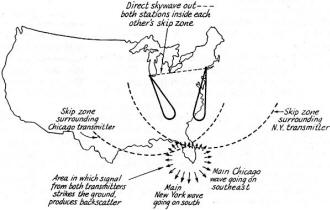
Fig. 1 - Point-to-point communication by ground scattering
after layer reflection over the great circle path has failed.
Want to keep a schedule with someone seven or eight hundred miles away after
the 20-meter band has "gone dead" at night? Thanks to a recent discovery in which
amateurs have played a part, it is now possible to do this without shifting down
to a lower frequency and battling the usual QRM. By taking advantage of a new type
of radio propagation known as "meteor scatter," two stations can communicate far
beyond ground-wave range all night long and have the band essentially to themselves.
Furthermore, QSOs can be carried on by this means all day long too, even though
the station at the other end is well inside the skip zone at all times. And best
of all, here is one type of reasonably long-distance radio transmission which promises
not to be subject to fadeouts, ionospheric storms, and all the other uncertainties
which plague the regular ionospheric layers.
Schedules using this type of propagation should be 100 per cent successful.
The catch? Yes, there is one, for new types of propagation such as this don't
keep themselves hidden all these years without good reason. The disadvantage is
that at amateur power levels, it is necessary to be content with a fairly weak signal,
and one which fades fairly rapidly between very wide limits. The signal is on the
average too weak for satisfactory telephony, but is adequate for c.w. It makes occasional
brief dips into the noise, but promptly comes back again. It will often rise twenty
or thirty decibels above the noise, for as much as five or ten seconds at a time.
The astonishing part of the matter is that the signal - at least some signal - is
there substantially all of the time, even when the band, by every normal criterion,
should be completely dead!
What does one need to take advantage of this form of transmission? Nothing more
than an efficient station, and some knowledge of what to expect. Briefly, the explanation
of the signal - at least in the vicinity of 20 meters - is forward scattering from
ionization trails left behind by the myriads of tiny meteors which pepper the E
region of the ionosphere at all times. Hence the maximum range for this form of
transmission is essentially that for normal one-hop E-layer transmission, or 1500
miles. For reasons which will be brought out later a good transmission distance
in practice is about half this value, or around 800 miles.
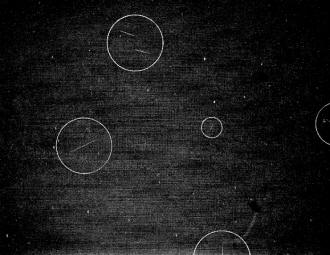
Visible meteors during a shower: a two-second exposure during
the great Draconid display of October, 1946. Lines drawn through individual meteor
trails (inside circles) intersect a t a common point known as the shower radiant.
Thousands of meteors too small to be seen - but producing radio reflections - strike
the E region of the ionosphere at all times.
In view of .the low height of the E region - roughly 70 miles - the vertical
angle of take-off even for the shorter distance is quite low - of the order of 5
or 6 degrees. Thus a good site is a requirement: one which does not have nearby
mountains or apartment houses screening off low-angle radiation in the desired direction
of communication. An antenna well up in the air, a sensitive receiver, and a location
reasonably free of man-made QRN are also important. If this sounds formidable, remember
that these are no more than the requirements for reasonably good DX results. A "full
gallon" is not essential - two or three hundred watts will do, although the more
the merrier. It follows that many thousands of operators throughout the country
should be able to take advantage of this new type of extended-range transmission.
Ground-Scatter Transmission
How does this type differ from those to which we are already accustomed? The
story, briefly, is as follows. Consider two cities, say New York and Chicago, spaced
roughly 800 miles apart. (Any other two cities, spaced the same distance, would
do equally well.) Until fairly recently, it was thought that communication between
these two communities at frequencies below 30 megacycles could only be conducted
when the "regular" layers - F, E and sporadic-E - were sufficiently ionized to reflect
a signal from one city to another. The distance involved is much too great for ground-
or space-wave communication, and it is also too great for the extension of ground-wave
range caused by tropospheric bending, even if that effect were important at the
lower frequencies.
Not long ago, however, another mechanism for getting a signal from New York to
Chicago in the absence of direct reflection from an overhead layer has come to be
understood. This is the indirect bounce by back-scattering from the ground. When
the skip is so long that Chicago cannot hear New York directly, both Chicago and
New York may still be able to hear Miami, Florida. If the New York transmitter uses
a beam directed southward, it will lay down a strong signal all over the state of
Florida and the Atlantic Ocean on one side, and the Gulf of Mexico on the other.
A small but detectable part of this signal will be scattered in all directions by
water waves in the Gulf and the Atlantic, by houses and trees on the land, and so
forth. If the Chicago station also uses a beam directed at Florida, it will be able
to pick up scattered components of the signal originating in New York, and the two
stations will be able to communicate via Florida, as in Fig. 1. The indirect
signal will be much weaker than a direct bounce over the great circle path, and
will have a hollow, fluttery sound not unlike that of a DX station, but it will
be well above the noise level and perfectly readable for both voice and code. (See
description on page 74 of the 1953 ARRL Handbook.)
This type of scattering has been observed quite regularly by amateurs interested
in 50-megacycle DX, and has been given a variety of names including "rebound scattering"
and "reflected skip." The authors, who prefer to call it "ground scattering" since
this seems to be the more descriptive term, have shown some photographs illustrating
it in their article on scatter-sounding in the March, 1952, QST.1 Those
photographs show scatter echoes received at the same spot from which the initial
signal had been transmitted; it should be understood, of course, that ground scatter
echoes from a given transmitter can also be heard at other locations inside the
skip zone surrounding that transmitter. Thus a scatter-sounder in New York would
be heard in Chicago under conditions of Fig. 1.
Meteor Reflections
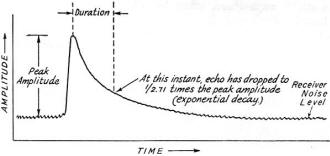
Fig. 2 - "Life history" of the most commonly-encountered
type of radio echo from a meteor trail. Shape is the same for either backward or
forward or forward reflection (see Fig. 3).
Now about the only remaining way to get a signal from New York to Chicago - if
we leave out the possibility of bouncing a signal from one place to the other via
exceptionally strong auroral ionization to the north - is by means of reflection
from a meteor column formed somewhere in the vicinity of the great-circle path.
It has been thought until recently that these meteor reflections were always
of short duration, and of no practical value for communication except perhaps during
an exceptionally strong meteor shower such as the great one of October, 1946. This
impression has stemmed from the fact that most observations of meteors have been
conducted with transmitter and receiver at one location, which is clearly the most
convenient experimental arrangement. Under these conditions relatively isolated
reflections, or signal bursts, are obtained.
Recent advances in understanding the nature of these reflections, however, have
led to some interesting conclusions.2 It is now known that there are
in general two types of meteor echoes. About 10 per cent of the total detected under
ordinary conditions have very long durations (ten seconds to ten minutes), strong
fading fluctuations, and an irregular and unpredictable "life history." Their behavior
is not yet well understood. The other 90 per cent of the echoes have a surprisingly
regular behavior, being characterized by a rapid rise to peak amplitude, followed
by a decay of exponential form as shown in Fig. 2. Since the decay is exponential,
it is convenient to define duration as the time interval between the peak and the
time at which the echo strength has dropped to roughly one-third the peak strength.
Thus this "duration" is analogous to the time constant of a condenser discharging
through a resistor.
Now it turns out that the height of the peak can be predicted quite accurately
for this type of echo, and varies inversely as the three-halves power of frequency,
assuming all other factors to be held constant. Thus, an echo having a peak of unit
strength at 14 megacycles will be less than one-third as strong at 28 megacycles.
Furthermore, the duration of this type of echo has been found to vary inversely
as the frequency squared. Thus if an echo lasts for one second at 14 megacycles,
the same echo would last only one-fourth of a second at 28 megacycles.
Lastly - and here is the payoff - it has been discovered that the duration of
a meteor echo at any given frequency, increases very rapidly when transmitter and
receiver are separated by several hundred miles. This increase factor is proportional
to the square of the secant of the forward-scattering angle 2φ in Fig. 3.
It works out that for a transmitter-to-receiver distance of 800 miles, the remote
reflection produced by a meteor column formed over the midpoint of the path will
have a duration more than twenty times that which it would have if the receiver
were adjacent to the transmitter.
Thus, by going to a relatively low frequency, such as 14 megacycles, we get stronger
echoes, and ones which have longer duration. Then, by changing from a backward to
a forward path, we get another increase in echo duration - and quite a large one
at that.
For some years, back-reflection experiments have shown that a truly astonishing
number of meteor echoes can be received even with relatively low-power equipment.
Measurements at Stanford University3 using equipment and power levels
substantially equivalent to that employed in a 1947 amateur experiment4
have shown that at a frequency of 23.1 megacycles, during the early morning hours,
several thousand meteor reflections per hour can be detected. This is at a rate
of nearly one per second. The average duration of each echo at this frequency may
be taken (conservatively) to be one-quarter of a second. This implies that on the
average, meteor echoes are present for nearly one-quarter of the total time.
If now the frequency is lowered to 14 megacycles, and an 800-mile forward bounce
is considered, the average duration of the meteor reflections is multiplied by a
factor of roughly 50 times! Thus, if one echo occurs each second, and each echo
lasts on the average twelve seconds, there will clearly be more than enough meteors
present to guarantee a continuous signal by meteor reflections alone.
This picture is, of course, greatly oversimplified, although it does represent
a fair approximation. For example, the area of the sky from which meteor echoes
are obtained for overhead reflection is not the same as it is for distant reflection.
However, when all the details are worked out, to the best of present knowledge,
there will be at 14 megacycles enough meteor reflections on the average at all times
of the day and year to guarantee a continuous signal between two amateur stations
separated by 800 miles and having moderate transmitter powers, good locations, and
simple beam antennas.
Accidental Discovery
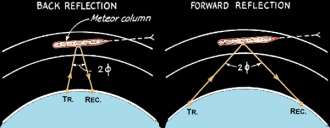
Fig. 3 - Illustrating backward and forward reflection (or
"scattering") from a meteor trail.
This effect was turned up accidentally by the authors during the course of the
W6YX scatter-sounding experiment,1 which consisted of a demonstration
that when echoes from a particular area appear on the scatter-sounder, strong signals
can actually be heard from amateur stations located in that area. The converse,
of course, was also investigated at the same time. In other words, the authors were
just as eager to be able to show that when no echoes appeared from a given area,
amateur signals could not be received from that area, either. This proved to be
a tricky proposition, as was pointed out, because as long as any echoes appear anywhere
on the indicator, it is always possible for a station in a supposedly "dead" region
to be heard weakly by ground scattering via the area from which the echoes are coming.
It was decided that the most convincing test would be to wait until late on a
night after all F, E, and sporadic-E activity had disappeared, and the indicator
showed no echoes at all. Such nights are actually few and far between on the West
Coast during the months of November and December. When one was at last found, a
'phone call was put through to Rod Beaudette, W7FXI, at Spokane, Washington, about
750 miles airline from Palo Alto. Rod, a Stanford graduate who had participated
in the early meteor experiments at W6YX, has 500 watts on the air feeding a 3-element
beam perched 30 feet above the roof of his house in suburban Spokane. At his location
the ground slopes off toward the south (the direction to Palo Alto), and there are
no intervening mountains to block off the horizon. Aside from this, Rod's location
might be termed average, having the usual number of impedimenta in the form of light
lines, neighboring houses, etc. W6YX's location (at least for the north and south
directions) is better than average; the station is located atop a small hill one
or two hundred feet above the floor of the valley containing San Francisco Bay.
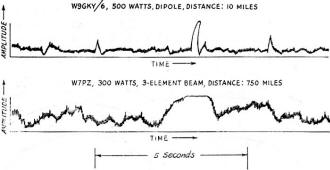
Fig. 4. - Forward and back-reflected meteor echoes at 14
megacycles. When these records were made (late at night), no layer propagation of
any kind could be shown to he present.
While Rod, wakened out of a sound sleep, good-naturedly went down into his basement
to turn on the rig, we at Palo Alto thoroughly crossed our fingers and patrolled
back and forth across an absolutely dead band. Suddenly, a signal! Could that drowsy-sounding
voice be Rod's? In our excitement, we placed another 'phone call to verify it. There
could be no doubt. Again we checked the amateur scatter-sounder. No sign of any
echoes. No sporadic-E at all, and F-reflections had died out hours earlier. Yet
there was W7FXI: at times unreadable on voice - at others, easily readable and well
above the noise. During the dips, his carrier could always be copied by switching
on the b.f.o. C. w. reception was quite satisfactory without the crystal filter,
and much improved, of course, with it.
These tests were repeated as often as suitable conditions could be found, with
similar results on each occasion. The signal was definitely always there, when by
all rights nothing should be heard. Its characteristics at once suggested the meteor-scatter
explanation, and instantaneous field-intensity recordings strengthened this impression.
In addition to bursts, nose whistles and "body Dopplers" could easily be seen superimposed
on the continually-fading, but almost-always-present background. As is to be expected,
the duration of the big bursts over this long path was, on the average, far greater
than anything we had experienced during the course of local tests. Fig. 4 illustrates
this effect by showing the comparison between a recording of backward-reflected
meteor echoes obtained locally, and a similar recording of forward-reflected meteor
echoes over a 750-mile path. Echo overlapping in the latter case prevents accurate
determination of individual echo durations but the increased average duration is
clear.
Other Paths
In the thought that there might be some-thing magic about the path to Spokane,
similar tests were carried out with W7PZ in Tucson, Arizona - about 750 miles away
in a south-easterly direction. Ben has a three-element beam, about 300 watts, and
a location outside Tucson on flat land not far from the airport. His signals were
heard just as consistently as W7FXI's in Palo Alto.
In addition, W6HJT in San Marino - only 300 miles away and nearly south from
Palo Alto - also put in a very strong signal with a steady background underlying
the meteor bursts.
Attempts to increase the frequency or the distance met with less success, however.
Transmissions to and from Tucson on 10 meters resulted in a signal audible only
during well separated bursts, with no sign of a background between.
On one occasion, W0PRZ in Aberdeen, South Dakota, was asked to listen for the
20-meter W6YX signal. His distance is near the maximum for one-hop E-layer reflection:
about 1400 miles. During the course of a 15-minute transmission, only one or two
distinct bursts were heard. His antenna, location and equipment are top-flight,
as his DX record shows, so the conclusion seems to be that at extreme range the
number of meteors which can produce a signal over the path (they have to be just
about exactly over the midpoint) becomes so small that a continuous background is
not supported. Also, the angle of take-off becomes so low (down around one degree)
that antennas of practicable height are quite inefficient. The effect of varying
transmitter-receiver distance, with frequency and power constant, is shown in Fig. 5.
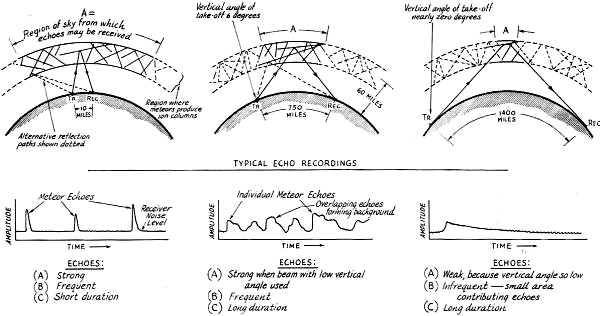
Fig. 5 - Effect of distance on meteor echo behavior, for
a given frequency and power.
Relationship to 50-Mc. Scattering
The theoretical investigations which followed these ham experiments confirm the
expectation that meteors alone can support the entire signal.5 ,6 However,
the possibility that other factors may be involved can by no means be ruled out.
There has recently been published an account of another new form of propagation,
in many respects resembling that discussed in this article, which is effective at
frequencies of the order of 50 megacycles and at very high power levels.7
It is suggested that this propagation may be explained as forward-scattering from
irregularities such as might be caused by turbulence in the E region of the ionosphere.
Meteors are cited as playing an important part. The observed signal, however, has
certain characteristics for which meteors would almost certainly not be responsible.
These characteristics, unhappily, are not easy to study at 15 megacycles. It
is not yet known to what extent, if any, the 15- and 50- megacycle signals arc caused
by the .same agency. The situation as of December, 1952, may be summarized in the
following way. At the lower frequency, theory indicates that meteors alone should
easily account for the observed signal. Nothing in the experimental evidence thus
far disagrees with this conclusion. At 50 megacycles, however, the theory -- based
on present knowledge of meteor echo behavior--predicts that they alone will not
be sufficient to account for what is observed. It appears that other factors must
be sought.
The unscrambling of the several factors which may contribute to the signal observed
at the two frequencies will be an exciting and challenging job. One of the first
tasks will be to gain as much experience with these new types of propagation as
possible. Here the amateurs, with their wide geographical distribution, and their
willingness to experiment at all hours of the day and night, are in a position to
make a real contribution. It is obvious that any means for making the 20-meter band
work around the clock (at least for 800-mile QSOs!) is going to be important as
crowding on the lower frequencies increases.
Furthermore, the invulnerability of meteors to ionospheric storms is another
important point: a weak, but really reliable circuit may, during emergencies be
worth much more than one which could fade out at the crucial moment.
Signal Strength
The strength of the meteor-scatter signal, and hence its usefulness in ham communication,
will depend on the efficiency of the stations involved. The antenna system is very
important, and should be designed to concentrate power where the most meteor scatter
is taking place - namely, in the E region over the midpoint of the great circle
path. For an 800-mile path, the main lobe of the pattern in the vertical plane should
ideally be at 6 degrees above the horizontal. At 20 meters a dipole should be 165
feet over perfectly-conducting earth, for the lowest lobe to be at 6 degrees! In
practice, whatever arrangement affords the highest gain consistent with a low vertical
angle will be best.
Almost any good station will be able to take advantage of meteor-scatter transmission
at 20 meters. At 15 meters, however, it is probable that only the kilowatt boys
will be able to transmit a usable background signal over the path. Stations having
good locations and rotary beams (or preferably rhombics), and willing to use maximum
receiver crystal selectivity, will no doubt be able to make a go of it. (As frequency
goes up, echo strengths and durations go down, but since the echoes are exponential,
the net loss can be overcome by an increase in power or receiver sensitivity.) In
any case, a c.w. clipper or limiter will be very worthwhile. Otherwise, when gain
is advanced enough to copy weak passages, meteor bursts tend to be deafening.
Note that the preceding remarks on signal strength apply to those times of day
when meteor scatter is the only form of transmission taking place. Actually, for
much of any given day the signal will be well above the purely meteor level. Any
sporadic-E activity, for example, will enormously increase the strength of the received
field. (During one memorable test with W7PZ, sporadic-E set in and within a minute
or so transformed his randomly-fading S1 meteor-scatter transmission into a rock-solid
S9 signal with a very slow, almost perfectly sinusoidal amplitude variation.) Whenever
any F-layer transmission is in at all, of course, there will be a strong ground
back-scatter component present along with the meteor-scatter.
Thus the timetable for 14-Mc. transmission over a New York-Chicago path, during
the winter months of the year, might run something like the following:
8 P.M. - 7 A.M. meteor scatter alone weak signal
7 A.M. - 9 A.M. meteor plus F-layer ground scatter medium signal
9 A.M. - 5 P.M. direct F-layer transmission very strong signal
5 P.M. - 8 P.M. meteor plus F-layer ground scatter medium signal
(Sporadic E, which might come in at any hour of the day or night, would provide
a strong signal directly, or a weaker signal via ground scatter.)
Commercial Stations
The reader is probably wondering, at this point, why meteor-scatter propagation
has not previously been noticed on transmission from commercial stations. The answer
is that it probably has, but simply was not identified as such. Most broadcast or
commercial stations are in the habit of signing off after F-layer transmission fails,
so listeners seldom get much of an opportunity to hear meteor scatter. Once in a
while a station, transmitting according to a prearranged schedule, will stay on
the air after its frequency has "gone dead." This has happened, for example, in
the case of a 17-megacycle short-wave broadcasting station roughly two hundred miles
south of Palo Alto. Their beam points right at Stanford, on its way to the Orient,
and what is believed to be meteor scatter has been heard on many occasions.
WWV's transmissions on 15 and 20 megacycles, of course, provide a wonderful opportunity
to check for meteor scatter, and hams living within a radius of 1000 miles of Beltsville,
Maryland, are urged to tune in on WWV and satisfy themselves that the 20-meter band
really doesn't go entirely dead, at night, after all!
Acknowledgment
The authors are indebted to W6VUW, W6UGL, W6LLK, W6AOF and other members of the
Stanford Radio Club for assistance during the tests. The help of Larry and Clayte
at W7TMK is also appreciated. The loan of recording equipment belonging to a joint-Service-sponsored
research project is gratefully acknowledged. The photograph of meteors during a
shower was taken by L. A. Manning, W6QHJ.
* Trustee, W6YX; Dept. of Electrical Engineering, Stanford University, Stanford,
Calif.
** Radio Propagation Laboratory, Stanford University, Stanford, Calif.
1 O. G. Villard, jr., and A. M. Peterson, "Instantaneous Prediction of Radio
Transmission Paths," QST, Vol. 36, No.3, pp. 11-20, March, 1952.
2 Von R. Eshleman, "The Mechanism of Radio Reflections from Meteoric Ionization,"
Technical Report No. 49. Electronics Research Laboratory, Stanford University, Stanford,
Calif., July 15, 1952.
3 L. A. Manning, O. G. Villard, jr., and A. M. Peterson, "Radio Doppler Investigation
of Meteoric Heights and Velocities," Journal of Applied Physics, Vol. 20, No.5,
pp. 475-479, May, 1949.
4 O. G. Villard, jr., "Meteor Detection by Amateur Radio," QST, Vol. 31, No.7,
pp. 13-18, July, 1947.
5 O.G. Villard, jr., A. M. Peterson, et al., "Extended-Range Radio Transmission
by Oblique Reflection from Meteric Meteoric Ionization," Journal of Geophysical
Research, March, 1953 (in press).
6 Von R. Eshleman and L. A. Manning, "Radio Communication by Scattering from
Meteoric Ionization," Technical Report No. 57, Electronics Research Laboratory,
Stanford University, Stanford, Calif., December 1, 1952.
7 D. K. Bailey, et al., "A New Kind of Radio Propagation at Very High Frequencies
Observable over Long Distances," Physical Review, Vol. 86, pp. 141-145, April 15,
1952.
Posted April 28, 2020
(updated from original post on 4/11/2016)
|















